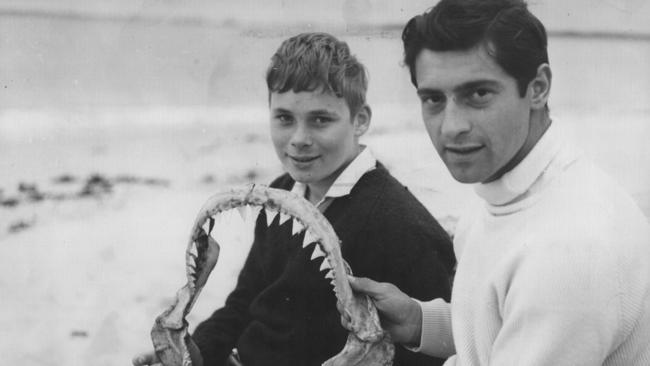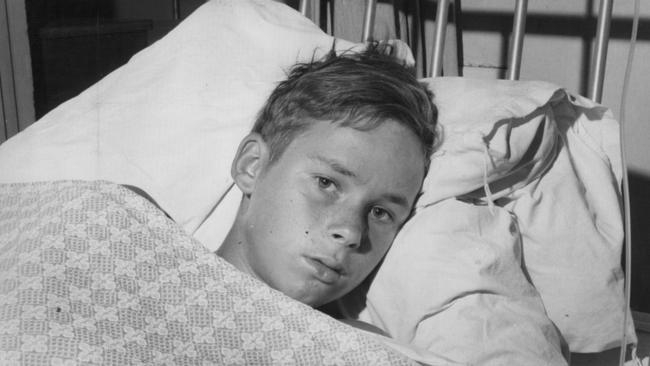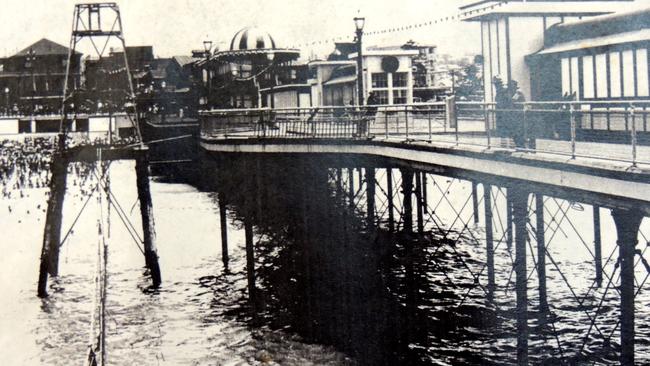Teenager Ray Short lucky to be one of 480 Aussies who lived to tell of surviving a shark attack
The mangled dent in Ray Short’s deformed left leg is a legacy of his near escape from a great white on a NSW beach almost 50 years ago.

Today in History
Don't miss out on the headlines from Today in History. Followed categories will be added to My News.
The mangled dent in Ray Short’s deformed left leg is a legacy of his near escape from a great white on a NSW beach almost 50 years ago. The shark was still attached as lifesavers dragged Short out of the water in February 1966 in a rescue enshrined in Coledale Surf Life Saving Club legend.
Short is among 480 Australians who have lived to tell the tale of surviving a shark attack since European settlement began in 1788. Another 184 were not so fortunate, earning Australia top place on the international list for fatal shark attacks.
Short, 13, had spent the weekend at Coledale with his parents and elder brother when he went swimming alone at two on Sunday afternoon. About 30m out in choppy, murky water, a 2.5m shark grabbed his left thigh, then let go. As Short started for the shore, the shark looped back and swallowed his leg up to his left knee.

PUNCHING THE SHARK
“I know I tried to punch the shark off many times,” he recounted from his hospital bed. “Then I bit it on the nose, but it still wouldn’t let go.”
Half a dozen lifesavers rushed into the water, where Raymond Joyce realised Short was too heavy and apparently weighed down. As they reassured Short the shark had gone, Warren Haberley felt, then saw, that it was still attached.
“It wouldn’t let go,” said Haberley.
“Three of us grabbed its tail, but we were almost to the beach in knee-deep water when it finally let go.”
Rescuers dragged the shark onto the beach, where an examination the next day revealed extensive injuries, consistent with an attack by a shark of a similar size.
SHARK ATTACK CAPITAL
The US mainland tops the International Shark Attack File, based at the University of Florida, with 1104 attacks between 1580 and 2014, although only 35 were fatal. Frequent attacks earned an area off San Francisco the title of Red Triangle, but New Smyrna Beach in Florida ranks as the world’s shark attack capital.
Experts estimate anyone who has swam at New Smyrna has been within 3m of a shark, most commonly sighted in September. The beach adjoins river and canal inlets into the Atlantic Ocean, where sharks feed on baitfish found in murky water around the shoulders of stone jetties.
Sharks were officially recognised as a “menace” in NSW in 1929 after several incidents at ocean and Harbour beaches, although the report noted “experience indicates sharks do not patrol our beaches merely for the sake of an occasional human meal”.

Although shark attacks were less frequent in Western Australia, with 78 attacks and 12 fatalities since 1788, in 1927 Fremantle Council became Australia’s first to use “shark-proof devices”. The council purchased steel nets, used during World War I to protect ships from torpedoes, from the British Admiralty to enclose about .5ha at South Beach.
Mosman Council was among the first in NSW to consider shark nets, although its 1929 proposal for harbourside Edwards beach was criticised by a former alderman, as the nets would cost up to £40,000 for a beach where there had never been a shark attack.
CAUGHT IN A NET
Shark nets were erected at Bondi in March 1929 as “special precautions ... to protect surf bathers from sharks, in view of several recent tragedies. Experiments are being made with steel nets, buoyed by huge steel drums”.
Nets at Coogee Beach “were the centre of much controversy” at surf-life saving club meetings in September, 1931, because patrol duties had increased as more swimmers attempted to reach the net. But Coogee was also the only club in Australia to host a night surf carnival.
As Newcastle surfers agitated for the council to install nets at city beaches, shark catcher and net advocate Norman Caldwell, who regularly netted 30 sharks around Port Stephens, reassured holiday surfers by setting nets off fishing launches at Newcastle and Stockton beaches on Christmas Day, 1932.
When the NSW government established a Shark Menace Advisory Committee in 1934, chief Norris Merrett estimated nets for seven metropolitan surf beaches, including Manly, Coogee and Bronte, would cost about £34,000.
Temporary nets at Bondi caught two sharks before a surf carnival in March, 1935. Permanent nets erected at beaches between Palm Beach and Cronulla in 1937 caught about 1000 sharks in 12 months. Between 1950 and 2002, more than 11,500 sharks were caught and killed in the nets, with annual shark deaths in nets ranging from 69 to 648.
MONSTERS HAUNTED ANCIENT CIVILISATIONS
The fearful relationship between people and the monsters of the sea is depicted on a vase found at Ischia in Italy, most likely crafted circa 725BC, which shows a sharklike fish attacking a man. Greek poet Oppian described the Ketea and wrote of a sponge diver cut in two by a “huge and hideous beast” in his Halieutica in the 2nd century. In a wonders of creation compendium, Iraqi judge Zakariya Qazwini in 1270 described a “great evil in the sea” that travelled into the Tigris River.
Originally published as Teenager Ray Short lucky to be one of 480 Aussies who lived to tell of surviving a shark attack


